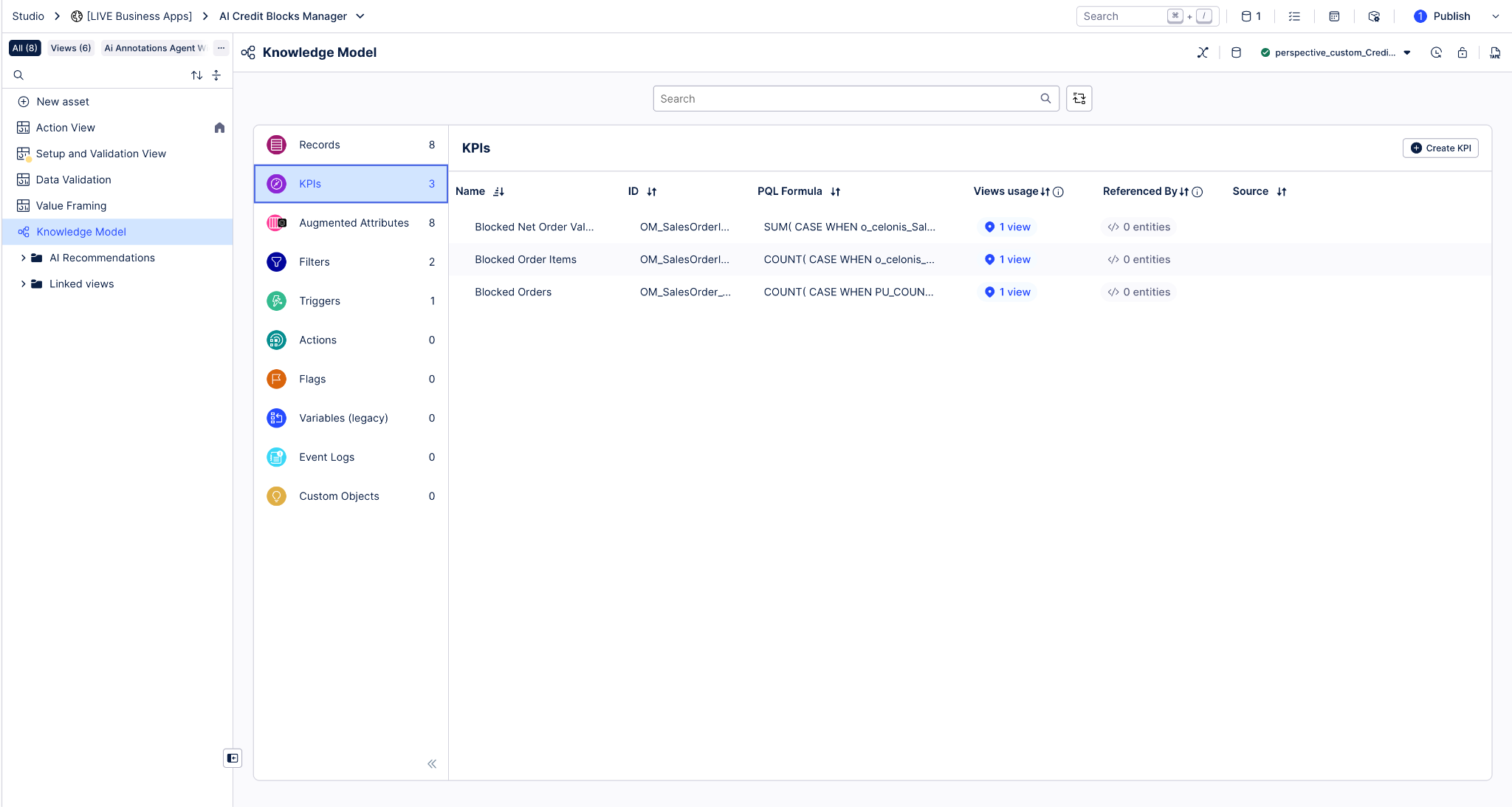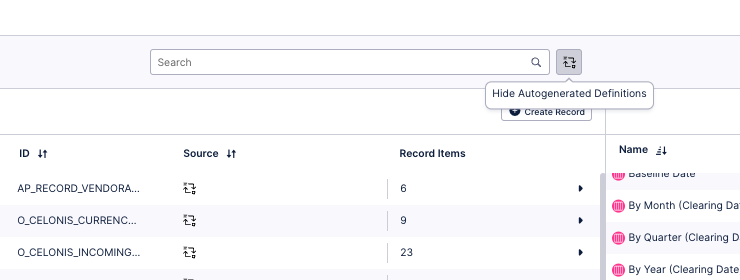Validating KPIs for the object-centric AI Credit Blocks Manager App
Work with the Setup and Validation view to change the default parameters for the AI Credit Blocks Manager app. We explain how we calculate each KPI and the default parameters the app uses. You can adjust their values to align with the way things are done in your organization.
After you publish an app for the first time, changing variable values in the Setup and Validation view in Studio doesn’t change their values in Apps. After publishing, you’ll need to work with the views in the Apps area for the values of the settings to be applied to end users. It’s best to keep the two sets of variable values in sync so that your results in Studio match those in Apps.
The Setup and Validation view is the best way to validate and adjust the KPIs in the AI Credit Blocks Manager app’s Knowledge Model. If you’ve worked through your use case, but something is still not how you want it, you can make further adjustments directly in the Knowledge Model in Studio.
The Knowledge Model for the AI Credit Blocks Manager app is called “Knowledge Model”.You’ll need Analyst permissions on Studio and the Knowledge Model to update it. Each KPI contains a PQL (Process Query Language) formula, which you can change in our editor to change how the KPI behaves. Your changes are applied when you publish a new version of the app.
The Knowledge Model also includes calculated attributes that contain the business logic to classify and provide metadata about objects. You can use them in PQL queries as if they were another column in the database table for the object type. They appear in the Knowledge Model as attributes of relevant records. If you make any edits to view components that involve the calculated attributes from the Knowledge Model, the Calculated Attributes in the Knowledge Model will be automatically updated to match your edits. You can adjust them directly in the Knowledge Model before or after editing the views.
Calculated attributes and PQL formulas might be reused in the calculations for several KPIs across the Knowledge Model. If you change the business logic in one location and save your change, all KPIs that reuse the calculated attribute or PQL formula will reflect your changes.
 |
Here’s how to work with the KPIs and calculated attributes in the app’s Knowledge Model. Check out the training track “Build Knowledge Models and Views” on the Celonis Academy if you need training.
In the Celonis navigation menu, select Studio.
In the Studio overview, find the AI Credit Blocks Manager app in the space where you installed it, and click its tile.
Select the Knowledge Model from the app navigation.
Select the KPIs section of the Knowledge Model to work with KPIs, or the Records section to work with calculated attributes. To see only the records with calculated attributes and see only the calculated attributes on those records, click the Hide Autogenerated Definitions icon by the search bar.

To see and edit the complete PQL formula and other settings for a KPI or calculated attribute, click its row to open an editor. The editor automatically validates any changes that you make in the PQL formula.
If you want a full-featured PQL editor that lets you select from the tables and columns in your data, click on the pen icon next to the PQL formula.
If you need to disable a KPI or formula, click the three vertical dots at the top of the editor, and select Disable Scope, and then click Disable to confirm. When you do this, the object can't be accessed or used anywhere in the package, including other apps that depend on it.
When you’ve changed the KPIs and calculated attributes, use the Publish button at the top of the screen in your Studio space to publish a new app version.
For the AI Credit Blocks Manager app, you can manage the settings for most of the important KPIs using the Validation and Value Assessment view and Settings view. The important KPIs that you can only manage in the Knowledge Model are:
KPI name | KPI ID | Description |
|---|---|---|
Blocked Net Order Value | OM_SalesOrderItem_NetOrderValueWithCreditBlock | Total net order value of all open sales order items due to a credit block |
Blocked Order Items | OM_SalesOrderItem_OpenSalesOrderItemsWithCreditBlock | Total number of open sales order items that are currently not closed due to credit block |
Blocked Orders | OM_SalesOrder_OpenSalesOrdersWithCreditBlock | Total number of open sales orders that are currently not closed due to a credit block |
Here are the most critical calculated attributes for the AI Credit Blocks Manager app:
Calculated Attribute name | Attribute ID | Record ID | Description |
|---|---|---|---|
Remaining credit balance | RemainingCreditBalance | O_CUSTOM_CREDITACCOUNT | The difference between the credit exposure and the credit limit. |
Open sales order value | OpenSalesOrderValue | O_CUSTOM_CREDITACCOUNT | Sum of all “approved” sales orders without a delivery created |
Open delivery value | OpenDeliveryValue | O_CUSTOM_CREDITACCOUNT | Sum of all value from sales orders with a delivery created |
Open invoice value (SD) | OpenInvoiceValue | O_CUSTOM_CREDITACCOUNT | Sum of all value from invoices still in the SD side that dont have a customer account item created yet |
Exposure amount | ExposureAmount | O_CUSTOM_CREDITACCOUNT | A sum of all of the credit exposure for the account. This includes open sales orders, deliveries, invoices, AR and blocked sales orders. |
Blocked value | BlockedValue | O_CUSTOM_CREDITACCOUNT | The credit value sum of the sales orders blocked by credit. |
Overdue debt | OverdueDebt | O_CUSTOM_CREDITACCOUNT | Sum of the invoices that are passed their due date. |
Due date | DueDate | O_CUSTOM_CUSTOMERACCOUNTITEM | Calcualtes the due date for the customer account item |
Is invoice cleared? | IsCleared | O_CUSTOM_CUSTOMERACCOUNTITEM | Checks whether the invoice is cleared |
Payment Classification | PaymentClassification | O_CUSTOM_CUSTOMERACCOUNTITEM | Logic for whether an invoice is late, early or on-time. |
Days past due | DaysPastDue | O_CUSTOM_CUSTOMERACCOUNTITEM | How many days have passed since the due date for documents not cleared. |
Credit block reason | CreditBlockReason | O_CELONIS_SALESORDER | All of the reasons for a credit block. These can be single or multiple for each sales order. |
Has credit block? | HasCreditBlock | O_CELONIS_SALESORDER | Checks if the sales order has a credit block |
Sales order has open sales order items | IsOpen | O_CELONIS_SALESORDER | Checks if the sales order is open and should be shown in the Action view. |
Credit value | CreditValue | O_CELONIS_SALESORDER | The sales order value from multiplying the credit price times the quantity for every item of the sales order. |